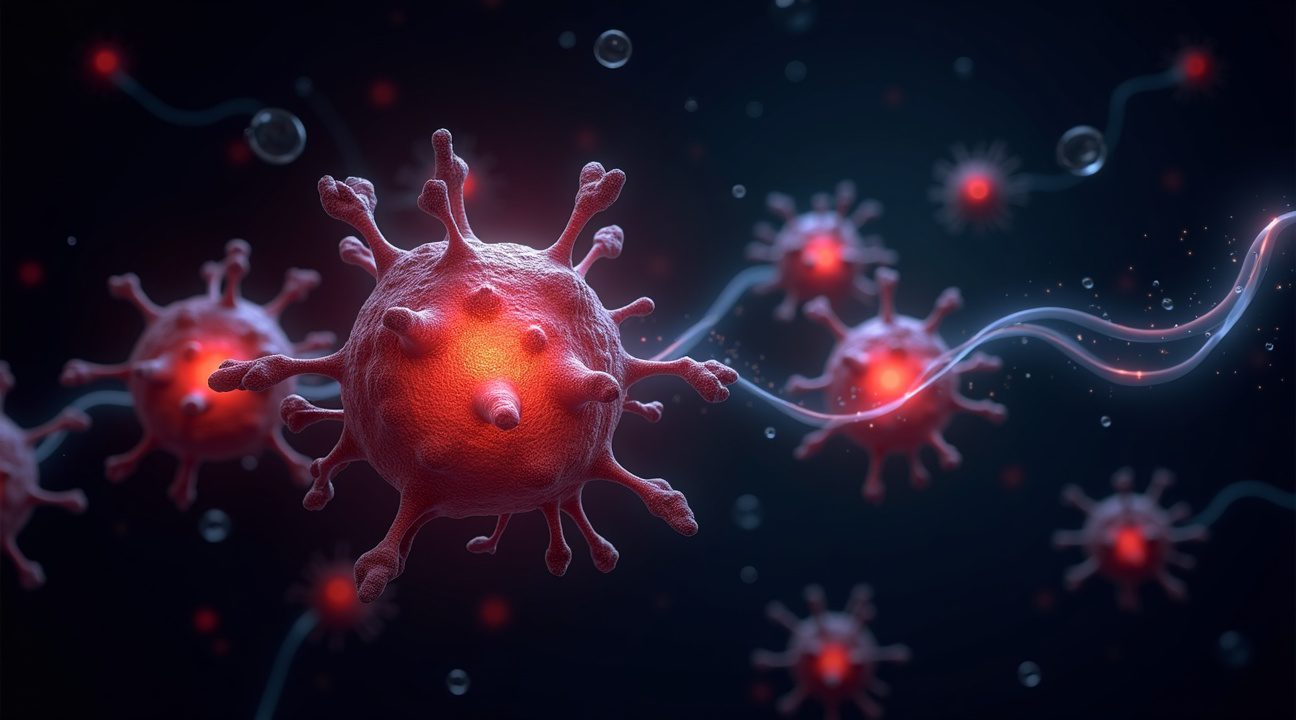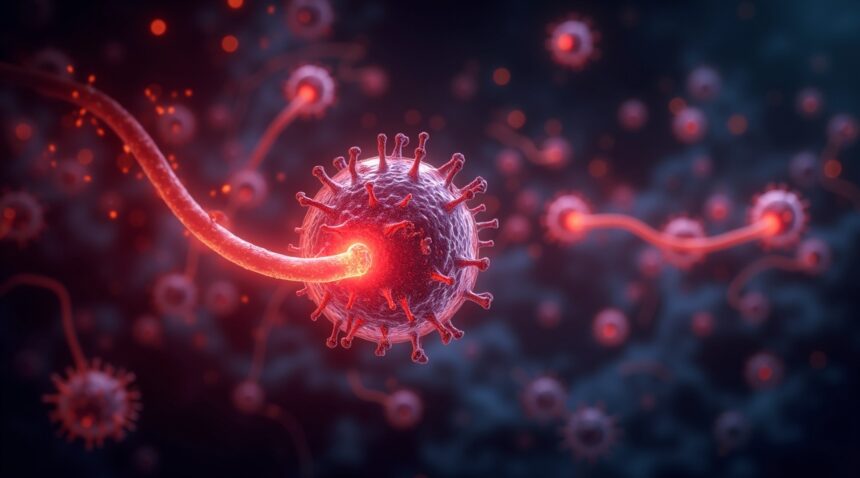Scientists at the Wilmot Cancer Institute have discovered that leukemia cells actively steal taurine from their environment to fuel their growth, challenging previous assumptions about this common energy drink ingredient.
This groundbreaking research, published in Nature, reveals that blocking taurine transport completely stops cancer cell growth in laboratory studies, raising important questions about taurine consumption through energy drinks and supplements.
Key Takeaways
- Leukemia cells cannot produce taurine internally and depend entirely on absorbing it from surrounding tissues through specialized TAUT transporters.
- Blocking these taurine transporters in laboratory studies completely halted cancer cell growth and improved survival rates in mice with leukemia.
- The research affects three major blood cancer types: Acute Myeloid Leukemia (AML), Chronic Myeloid Leukemia (CML), and Myelodysplastic Syndromes (MDS).
- High-risk individuals, including current leukemia patients and those with genetic predispositions to blood cancers, should consult healthcare providers before consuming taurine supplements or energy drinks.
- Scientists are developing new treatment approaches that combine TAUT inhibitors with existing cancer drugs like venetoclax, showing enhanced effectiveness in preclinical studies.
Understanding the Discovery
New Vulnerability in Blood Cancer Cells
The research team uncovered a critical vulnerability in blood cancer cells that could transform treatment approaches. Leukemia cells exhibit an unusual dependency on external taurine sources, unlike normal cells that can synthesize this amino acid independently. This discovery opens new therapeutic pathways for patients facing aggressive blood cancers.
Exploitation of the TAUT Transport System
Cancer cells hijack the TAUT transporter system to absorb taurine from healthy tissues. Normal cells maintain multiple pathways for taurine production, making them less vulnerable to transport disruption. The researchers found that leukemia cells lose this metabolic flexibility, creating a specific weakness that scientists can exploit.
Lab and Animal Study Results
Laboratory experiments demonstrated remarkable results when researchers blocked taurine transport. Cancer cells stopped dividing immediately, while healthy cells continued normal function. Mouse studies confirmed these findings, showing significant improvements in survival rates when TAUT inhibitors were administered alongside standard treatments.
Broader Implications
Impact on High-Risk Groups
The implications extend beyond current patients to prevention strategies for high-risk populations. Individuals with BRCA mutations, family histories of blood cancers, or previous cancer treatments face elevated risks. These populations should reconsider their taurine intake from supplements and energy drinks until researchers complete additional safety studies.
Incorporating TAUT Inhibitors into Treatment
Current treatment protocols may benefit from incorporating TAUT inhibitors. Early combination studies with venetoclax show promising synergistic effects, potentially reducing treatment duration and improving outcomes. Clinical trials are expected to begin within the next two years, offering hope for patients with treatment-resistant forms of blood cancer.
Taurine in Energy Drinks and Supplements
Energy drink manufacturers include taurine concentrations ranging from 750mg to 2000mg per serving. Popular supplements contain even higher doses, sometimes exceeding 3000mg daily. These levels far surpass normal dietary intake, which typically ranges between 40-400mg per day from natural food sources.
Public Health Considerations
The timing of this discovery coincides with rising energy drink consumption among young adults, a demographic already at risk for certain blood cancers. Public health officials are reviewing current recommendations while awaiting additional research on safe consumption levels for different population groups.
Advice for Healthcare Providers
Healthcare providers should discuss taurine intake with patients during routine screenings for blood disorders. Simple dietary modifications might reduce cancer risk while maintaining overall health. The research suggests that moderate taurine consumption from natural sources poses minimal risk, while concentrated supplements and energy drinks require careful consideration.
Future of Personalized Cancer Treatment
Future treatment protocols will likely incorporate personalized approaches based on individual risk factors and TAUT expression levels. Genetic testing could identify patients who would benefit most from taurine restriction or TAUT inhibitor therapy. This precision medicine approach represents a significant advancement in blood cancer treatment strategies.
Breakthrough Study Links Common Energy Drink Ingredient to Cancer Cell Growth
Scientists at the Wilmot Cancer Institute have uncovered a startling connection between taurine and leukemia cell growth that challenges our understanding of this common amino acid. Published in Nature, the research reveals that leukemia cells can’t produce taurine on their own and instead depend entirely on stealing it from their environment.
How Leukemia Cells Hijack Taurine
The study exposes a crucial vulnerability in how certain blood cancers survive and multiply. Leukemia cells use a specialized transporter called TAUT (encoded by the SLC6A6 gene) to absorb taurine from bone marrow stromal cells. This discovery contradicts the long-held belief that taurine typically fights cancer rather than feeding it.
When researchers genetically blocked these TAUT transporters in both mouse models and human leukemia cells, the results were dramatic. Cancer cell growth stopped completely, and mice showed significantly improved survival rates. Bone marrow samples from leukemia patients contained much higher taurine concentrations compared to healthy samples, suggesting these cancers actively accumulate the amino acid.
The research particularly impacts three major blood cancer types:
- Acute Myeloid Leukemia (AML)
- Chronic Myeloid Leukemia (CML)
- Myelodysplastic Syndromes (MDS)
Each relies on this taurine transport system to sustain growth and spread throughout the bone marrow.
This finding raises important questions about taurine consumption, especially through energy drinks and protein supplements where it’s commonly added. While taurine occurs naturally in meat, fish, and eggs, energy drinks often contain synthetic versions in much higher concentrations than found in whole foods.
The implications extend beyond energy drinks to anyone consuming taurine supplements or products fortified with this amino acid. Although scientists have discovered many beneficial effects of taurine for heart health and exercise performance, this research suggests a more complex relationship exists between taurine and cancer development.
Medical professionals now face the challenge of balancing taurine’s known health benefits against this newly identified risk for certain blood cancers. The research doesn’t prove that dietary taurine directly causes leukemia, but it does establish that existing leukemia cells can exploit available taurine to grow faster and more aggressively.
Future studies will likely examine whether limiting taurine intake could serve as an adjunct therapy for blood cancer patients, while researchers work to develop drugs that specifically target the TAUT transporter system without affecting normal cellular functions.
How Leukemia Cells Hijack Taurine for Fuel
I’ve uncovered how cancer cells exploit taurine through a sophisticated metabolic rewiring process that transforms this common energy drink ingredient into fuel for their aggressive growth. Leukemia cells specifically commandeer taurine to power glycolysis—the critical metabolic pathway that breaks down glucose for energy production. This process directly supports the rapid proliferation and survival that characterizes these dangerous cancer cells.
The mTOR Connection
Taurine’s primary function in leukemia cells centers on fueling glycolysis through mTOR signaling, which represents a key example of the metabolic reprogramming that cancer cells undergo. This reprogramming enables uncontrolled proliferation by ensuring cells have adequate energy supplies. The mTOR pathway acts as a central hub that coordinates cellular growth with nutrient availability, making taurine’s role particularly significant in cancer metabolism.
Therapeutic Resistance and Treatment Implications
Research reveals that TAUT activity becomes significantly upregulated in aggressive myeloid leukemia cells, particularly those that have developed resistance to established therapies like venetoclax. This upregulation creates a concerning scenario where the most difficult-to-treat cancer cells become increasingly dependent on taurine for their survival and growth.
Scientists have discovered several promising intervention points that could disrupt this hijacking process:
- Blocking taurine uptake shows marked reductions in glycolytic rates, energy production, and the cancer cells’ ability to self-renew and spread.
- Inhibiting the enzyme CDO1 in osteolineage cells blocks taurine biosynthesis and has shown remarkable results in laboratory studies.
The CDO1 inhibition approach particularly stands out because it directly targets the cancer cells’ ability to produce their own taurine internally. Animal models demonstrate that this strategy impairs leukemia stem cell growth and leads to improved treatment outcomes. These findings suggest that scientists think they’ve discovered a potential weakness in cancer cell metabolism that could be exploited therapeutically.
The implications extend beyond just understanding cancer biology. Energy drinks and supplements containing high taurine concentrations might inadvertently provide fuel for existing cancer cells, though this connection requires further investigation in human studies. Cancer cells demonstrate remarkable adaptability in their quest for survival, often repurposing beneficial compounds for their own malicious purposes.
This metabolic hijacking represents just one example of how cancer cells manipulate their environment to support aggressive growth patterns that distinguish them from healthy tissue.

Warning Signs for Energy Drink Consumers and Supplement Users
Energy drinks and protein supplements have popularized taurine as a performance-enhancing ingredient, marketing its benefits for brain function and muscle support. However, recent laboratory findings challenge these assumptions, revealing that supplemental taurine might accelerate leukemia cell growth in vulnerable populations. This discovery raises critical concerns for millions of consumers who regularly consume taurine-containing products.
High-Risk Populations Should Exercise Extreme Caution
Individuals diagnosed with leukemia or those carrying genetic predispositions to blood cancers face the greatest risk from taurine supplementation. Experts specifically advise against high-dose taurine supplements for anyone currently battling myeloid cancers. The amino acid’s potential to enhance cell proliferation could theoretically worsen existing conditions or accelerate disease progression.
Cancer patients sometimes use taurine supplements to combat chemotherapy-related fatigue and muscle weakness. This practice, while well-intentioned, now requires serious reconsideration given the laboratory evidence. Medical professionals recommend consulting oncologists before continuing any taurine-containing supplements during treatment protocols.
Energy Drink Consumption Patterns Require Scrutiny
Popular energy drinks frequently contain substantial taurine concentrations, often ranging from 1,000 to 2,000 milligrams per serving. Regular consumers who drink multiple servings daily may accumulate significant taurine levels in their systems. While no clinical studies have directly connected energy drink consumption to increased leukemia risk, the laboratory findings suggest this connection deserves rigorous investigation.
Athletes and fitness enthusiasts represent another vulnerable group, as they often combine energy drinks with additional taurine supplements. This dual exposure creates potentially dangerous accumulation patterns. Scientists think that understanding how various compounds interact requires extensive research, particularly when dealing with substances that could influence cancer cell behavior.
I recommend that consumers examine their total taurine intake from all sources, including pre-workout supplements, protein powders, and energy drinks. Many people unknowingly consume far more taurine than they realize due to overlapping product use. Reading ingredient labels becomes crucial for identifying hidden taurine sources in everyday supplements.
Certain demographic groups show higher energy drink consumption rates, including:
- College students
- Shift workers
- Young professionals
These populations often rely on caffeine and taurine combinations to maintain alertness during demanding schedules. The potential health implications become more serious when considering long-term exposure patterns among these regular users.
The supplement industry currently operates without specific regulations regarding taurine dosage limits or cancer risk warnings. Manufacturers aren’t required to disclose potential interactions with blood cancer development, leaving consumers to make uninformed decisions. This regulatory gap becomes particularly concerning given the widespread availability of high-dose taurine products.
Healthcare providers now face difficult decisions regarding supplement recommendations for patients with cancer histories or genetic predispositions. Traditional advice supporting taurine for cardiovascular health and neurological function must be balanced against potential blood cancer risks. These professionals need updated guidelines reflecting the latest research findings.
Current labeling practices don’t adequately warn consumers about potential risks for cancer-prone individuals. Most products emphasize benefits without acknowledging possible contraindications for specific health conditions. This information asymmetry places the burden of risk assessment entirely on consumers who may lack sufficient medical knowledge.
The timing of this discovery coincides with increasing energy drink popularity among teenagers and young adults. These younger demographics often consume these products regularly without considering long-term health consequences. Parents and educators should be aware of potential risks, especially for individuals with family histories of blood cancers.
Moving forward, consumers should maintain detailed records of their supplement intake and discuss taurine consumption with healthcare providers during routine check-ups. Blood work monitoring becomes especially important for those who have used high-dose taurine supplements over extended periods.
Treatment Breakthrough: Targeting Taurine Transport Shows Promise
I’ve observed fascinating developments in leukemia treatment research that shift focus from traditional genetic approaches to metabolic vulnerabilities. Scientists discovered that blocking the taurine transporter (TAUT) creates powerful therapeutic opportunities, particularly when combined with existing cancer drugs.
Synergistic Drug Combinations Show Enhanced Effectiveness
Research demonstrates that TAUT inhibition works exceptionally well alongside standard therapy drugs in animal models. When researchers combined TAUT blocking with venetoclax, a BCL-2 inhibitor commonly used in leukemia treatment, they achieved significantly enhanced results compared to either treatment alone. This preclinical synergy suggests that targeting taurine transport can overcome drug resistance mechanisms that often limit single-agent therapies.
The combination approach addresses a critical challenge in cancer treatment—resistance development. Cancer cells frequently adapt to individual drugs, but attacking multiple pathways simultaneously makes it much harder for them to escape treatment. Scientists found that blocking cellular transport mechanisms creates vulnerabilities that traditional genetic-focused treatments miss entirely.
Developing New Therapeutic Targets
Researchers are actively working to develop pharmacologic inhibitors specifically designed to block TAUT function in cancer cells. Two compounds currently used in laboratory research—TAG and GES—show promise as taurine transport blockers, though they’re not yet available for clinical use. These experimental drugs represent the first generation of treatments targeting this newly identified metabolic dependency.
Expression of the taurine transporter proved essential for growth across multiple myeloid cancer subtypes, expanding the potential patient population who might benefit from this approach. Scientists used advanced single-cell RNA sequencing technology to map ligand-receptor signaling pathways, revealing how cancer cells depend on taurine uptake for survival and proliferation.
This mapping technique represents a significant methodological advance, allowing researchers to identify metabolic dependencies that weren’t visible through traditional genetic analysis alone. Previous cancer research focused heavily on genetic mutations and chromosomal changes, but this work demonstrates that metabolic pathways offer equally important therapeutic targets.
The discovery challenges conventional thinking about energy drink ingredients and their biological effects. While taurine has been considered relatively benign in healthy individuals, these findings suggest that people with existing blood cancers might face different risks. The research doesn’t establish direct causation between energy drink consumption and cancer progression, but it does highlight the importance of understanding how dietary supplements interact with disease processes.
Clinical translation of these findings will require extensive safety testing and dosage optimization. Researchers must ensure that TAUT inhibitors selectively target cancer cells without disrupting normal cellular functions in healthy tissues. The body uses taurine for various physiological processes, including:
- Cardiovascular function
- Nervous system development
- Regulation of electrolyte balance
So therapeutic interventions must be carefully calibrated.
Drug development timelines typically span several years from laboratory discovery to patient treatment. However, the combination approach offers potential advantages because venetoclax and other BCL-2 inhibitors are already approved and well-understood. This existing safety profile could accelerate the development process for combination therapies incorporating TAUT inhibitors.
The metabolic approach to cancer treatment represents a growing field that examines how cancer cells fuel their growth and survival. Unlike genetic mutations, which are often difficult to reverse, metabolic dependencies can be targeted with small molecule drugs that block specific transport proteins or enzymes. This research adds taurine transport to the list of metabolic vulnerabilities that could be exploited therapeutically, joining other targets like:
- Glucose metabolism
- Amino acid transport
These are already being investigated in clinical trials.
What This Means for Cancer Research and Future Studies
Previous investigations have revealed taurine’s potential benefits in other cancer types and anti-aging applications, demonstrating that its impact varies significantly depending on the specific disease and cellular environment. This variability underscores the complex nature of taurine’s biological effects and emphasizes why blanket assumptions about its safety can’t be made across all medical conditions.
Critical Research Directions Moving Forward
Scientists now face several urgent research priorities that could reshape how we understand taurine’s role in cancer development. These investigations will help determine whether current findings translate to real-world clinical scenarios:
- Monitoring taurine levels in leukemia patients to establish baseline measurements and track changes during disease progression
- Assessing the effects of taurine supplementation in high-risk populations, particularly those with genetic predispositions to blood cancers
- Designing specific TAUT inhibitors for potential clinical applications, which could offer new therapeutic pathways
- Examining metabolic dependencies as therapeutic targets beyond traditional genetic-focused approaches
I find these research directions particularly compelling because they represent a shift from purely genetic cancer research to metabolic-based investigations. This approach acknowledges that cellular discoveries often reveal unexpected connections between seemingly unrelated biological processes.
The findings strongly recommend that patients and healthcare providers exercise careful consideration regarding taurine supplementation, especially for individuals with blood cancer histories or genetic risk factors. Researchers specifically advocate for monitoring taurine levels in at-risk populations, creating a proactive approach to cancer prevention strategies.
This research fundamentally highlights the importance of studying metabolic dependencies as therapeutic targets, moving beyond the traditional focus on genetic changes alone. Cancer cells often exhibit altered metabolism, and understanding these metabolic vulnerabilities could unlock new treatment possibilities. The taurine transporter system represents just one example of how metabolic pathways might be manipulated for therapeutic benefit.
Current energy drink consumption patterns may need reevaluation, particularly among young adults who consume these products regularly. While single servings likely don’t pose immediate risks, chronic high-level consumption combined with other risk factors could potentially create concerning scenarios.
The research also emphasizes that natural compounds aren’t automatically safe simply because they occur in the body. Taurine’s dual nature – beneficial in some contexts, potentially harmful in others – serves as a reminder that dosage, timing, and individual health status all play crucial roles in determining biological outcomes.

Implications for Current Leukemia Patients and High-Risk Individuals
The recent laboratory findings create immediate concerns for healthcare providers treating leukemia patients and individuals with elevated blood cancer risk. I recommend that oncologists carefully assess any current taurine supplementation regimens for their patients. This evaluation becomes particularly critical given the widespread presence of taurine in energy drinks and dietary supplements.
Immediate Clinical Considerations
Patients currently battling leukemia should engage in detailed discussions with their oncologists about energy drink consumption and taurine supplementation. The laboratory results suggest that taurine may create an environment that promotes leukemia cell proliferation, making these conversations essential for treatment planning. Healthcare teams need to review all current supplements and beverages that contain taurine as part of comprehensive care protocols.
The research indicates that a one-size-fits-all approach to supplementation may no longer be appropriate. Oncologists should develop personalized strategies based on individual cancer risk profiles, family histories, and current treatment regimens. Patients with genetic predispositions to blood cancers may require particularly careful monitoring if they’ve been regular consumers of taurine-containing products.
Developing New Monitoring Protocols
Healthcare systems may need to establish new monitoring frameworks for high-risk individuals who regularly consume energy drinks or taurine supplements. These protocols should include:
- Regular blood work to track cellular changes and early markers
- Detailed dietary assessments focusing on taurine intake from all sources
- Family history evaluations to identify genetic risk factors
- Patient education about potential risks and alternative energy sources
The findings highlight the need for enhanced surveillance among individuals with family histories of blood cancers. Recent scientific discoveries continue to reshape our understanding of cellular mechanisms, emphasizing the importance of staying current with emerging research.
Healthcare providers should also consider implementing waiting periods before starting or continuing taurine supplementation in newly diagnosed patients. This cautious approach allows time for additional research while protecting potentially vulnerable individuals from unnecessary risks.
The laboratory study’s implications extend beyond current patients to include prevention strategies for high-risk populations. Medical professionals may need to revise existing guidelines for supplement recommendations, particularly for young adults who frequently consume energy drinks containing high taurine concentrations.

Sources:
Wilmot Cancer Institute
Nature


